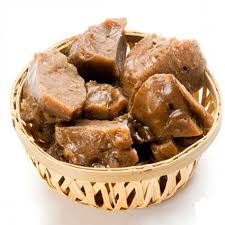Good Food Bar
Premium Raw Hing / Asafoetida
Premium Raw Hing / Asafoetida
Regular price
Rs. 249.00
Regular price
Rs. 1,199.00
Sale price
Rs. 249.00
Unit price
per
Couldn't load pickup availability
Raw asafoetida, also known as "hing," is a pungent and resinous spice derived from the dried sap of the root of the Ferula plant, primarily Ferula assa-foetida. It has a strong and distinctive flavor and is commonly used as a seasoning in various cuisines, especially in Indian and Middle Eastern cooking. Here is a description of raw asafoetida:
**1. Appearance:**
- Raw asafoetida is typically sold in solid resin form, often as small chunks or irregular-shaped pieces. It has a brownish-gray to yellow-brown color.
- The resin pieces are hard and can be crushed into a fine powder for culinary use.
**2. Aroma:**
- Raw asafoetida has a strong, pungent, and somewhat sulfurous aroma that is often described as unpleasant when smelled in its raw form.
- However, when cooked or heated in oil, its aroma transforms into a more savory and onion-like fragrance, which is highly valued in cooking.
**3. Flavor:**
- The flavor of raw asafoetida is intense and savory, with a pronounced garlic and onion-like taste. It adds depth and umami to dishes.
- In its raw form, the flavor can be overpowering, so it is typically used in very small quantities.
**4. Culinary Uses:**
- Raw asafoetida is used as a seasoning and flavor enhancer in a wide range of dishes, particularly in Indian cuisine. It is often a key ingredient in spice blends like curry powders and masalas.
- It is commonly used in vegetarian and vegan cooking as a substitute for the savory notes provided by garlic and onions, especially during fasting periods when these ingredients are restricted.
- It is usually added to hot oil or ghee at the beginning of cooking to release its flavors and aromas.
**5. Medicinal and Therapeutic Uses:**
- Asafoetida has a long history of use in traditional medicine, particularly in Ayurveda and traditional healing systems.
- It is believed to have digestive properties and is used to alleviate gas, bloating, and indigestion.
- In some cultures, it is used as a remedy for respiratory ailments and as an antispasmodic.
**6. Storage:**
- Raw asafoetida should be stored in an airtight container away from light and moisture to preserve its flavor and aroma.
**7. Note:**
- While raw asafoetida has a strong and somewhat off-putting aroma when smelled directly, it should not be confused with the milder and more palatable aroma it imparts when used in cooking. When properly used in small quantities, it enhances the flavor of dishes without overwhelming them.
**1. Appearance:**
- Raw asafoetida is typically sold in solid resin form, often as small chunks or irregular-shaped pieces. It has a brownish-gray to yellow-brown color.
- The resin pieces are hard and can be crushed into a fine powder for culinary use.
**2. Aroma:**
- Raw asafoetida has a strong, pungent, and somewhat sulfurous aroma that is often described as unpleasant when smelled in its raw form.
- However, when cooked or heated in oil, its aroma transforms into a more savory and onion-like fragrance, which is highly valued in cooking.
**3. Flavor:**
- The flavor of raw asafoetida is intense and savory, with a pronounced garlic and onion-like taste. It adds depth and umami to dishes.
- In its raw form, the flavor can be overpowering, so it is typically used in very small quantities.
**4. Culinary Uses:**
- Raw asafoetida is used as a seasoning and flavor enhancer in a wide range of dishes, particularly in Indian cuisine. It is often a key ingredient in spice blends like curry powders and masalas.
- It is commonly used in vegetarian and vegan cooking as a substitute for the savory notes provided by garlic and onions, especially during fasting periods when these ingredients are restricted.
- It is usually added to hot oil or ghee at the beginning of cooking to release its flavors and aromas.
**5. Medicinal and Therapeutic Uses:**
- Asafoetida has a long history of use in traditional medicine, particularly in Ayurveda and traditional healing systems.
- It is believed to have digestive properties and is used to alleviate gas, bloating, and indigestion.
- In some cultures, it is used as a remedy for respiratory ailments and as an antispasmodic.
**6. Storage:**
- Raw asafoetida should be stored in an airtight container away from light and moisture to preserve its flavor and aroma.
**7. Note:**
- While raw asafoetida has a strong and somewhat off-putting aroma when smelled directly, it should not be confused with the milder and more palatable aroma it imparts when used in cooking. When properly used in small quantities, it enhances the flavor of dishes without overwhelming them.



